Tuesday, 1st June 2021
Artemis Accords
In News
Recently, countries like South Korea and New Zealand have signed the Artemis Accords.
About the Artemis Accords
- The Artemis Accords are a mechanism by which countries can participate in NASA’s Artemis Programme. Via the Artemis program, NASA will land the first woman and the next man on the Moon by 2024. NASA likely sees this as a natural next step after the collaboration at the International Space Station.
- The Artemis Accords will describe a shared vision for principles, grounded in the Outer Space Treaty of 1967, to create a safe and transparent environment which facilitates exploration, science, and commercial activities for all of humanity to enjoy.
- The principles set out in these Accords are intended to apply to civil space activities conducted by the civil space agencies of each Signatory. These activities may take place on the Moon, Mars, comets, and asteroids, including their surfaces and subsurface, as well as in orbit of the Moon or Mars, in the Lagrangian points for the Earth-Moon system, and in transit between these celestial bodies and locations.
India and the Artemis Accords
- Space dependencies: Various dependencies of India in advanced space technologies may play a role in India’s decision on whether to join the Artemis Accords:
- The US has collaborated with India on Chandrayaan 1, and India is currently collaborating with Japan on a future lunar mission, called LUPEX, to the Moon’s surface. Japan is also a signatory to the Accords.
- The US, France, Germany and Italy in Europe, and Japan have also offered help to India with human spaceflight training.
- R & D Needs: For advanced R&D, it’s essential that India be an early participant in the Artemis Accords, so that it can gain lessons and expertise from other countries that are members of the accords. This could be things like deep space network expertise from the US and Australia.
- The Quad Factor: The accords form a natural extension of the Quad’s Critical and Emerging Technologies Working Group. The US, Japan and Australia are already signatories of the accords. India’s addition to the accords would provide a framework for space cooperation among these Quad countries.
- Global Supply Chain: By being a part of the accords, India’s space companies could become part of a global supply chain. This would also help attract investment capital towards Indian space startups and lead to flow of capital into India.
Sources: https://science.thewire.in/spaceflight/should-india-sign-the-artemis-accords/
https://www.nasa.gov/specials/artemis-accords/index.html
https://www.nasa.gov/specials/artemis-accords/img/Artemis-Accords-signed-13Oct2020.pdf
Climate Tipping Point
In News
UN World Meteorological Organization has recently released the Global Annual to Decadal Climate Update
About the News
- The projections are part of a recent WMO effort to provide shorter-range forecasts of temperature, rainfall and wind patterns, to help nations keep tabs on how climate change may be disrupting weather patterns.

- Likely Scenario is the 5-year range of 2021- 25:
- Increased warming: Annual mean global (land and sea) mean near-surface temperature is likely to be at least 1°C warmer than pre-industrial levels (defined as the average over the years 1850-1900).
- No breach of Tipping point: It is very unlikely (10% chance) that the five-year mean global near-surface temperature for 2021-2025 will be 1.5°C warmer than pre-industrial levels. So, the world will not be crossing the long-term warming 1.5-degree threshold set by the Paris Climate Accord, which scientists warn is the ceiling to avoid the most catastrophic effects of climate change.
- More rains and cyclones: Over 2021-2025, high latitude regions and the Sahel are likely to be wetter than the recent past.
- Current Observations:
- Most regions were warmer than the recent past. Warming was largest at high latitudes in the Northern Hemisphere, especially the Arctic, and generally larger over land than ocean, especially for the five-year mean 2016-2020.
- In the last five years, sea-level pressure was anomalously low in both polar regions, with strongest negative anomalies over Antarctica. Hence, both the Arctic and Antarctic Oscillations have been positive on average.
- Global (land and sea) mean near-surface temperatures have increased steadily since the 1960s. The period 2016-2020 is the warmest five-year period since records began in 1850.
Sources: https://hadleyserver.metoffice.gov.uk/wmolc/WMO_GADCU_2020.pdf
Threshold Level of Inflation – Concept and Measurement
In News:
The Reserve Bank of India recently released a study titled “Threshold level of Inflation – Concept and Measurement”
About the Study
- The study examines the concept of threshold inflation and tries to explain the relationship between threshold inflation and growth in a country.
- The study has been conducted by the Development Research Group (DRG), an RBI-backed independent research initiative. Its objective is to undertake quick and effective policy-oriented research backed by strong analytical and empirical basis, on subjects of current interest.
What is Threshold Inflation (TI)?
The concept of threshold inflation is linked to the level of inflation beyond which it becomes detrimental to economic growth. It is based on the long-term equilibrium inflation rate that maximizes the steady state rate of growth for the economy. It explicitly treats investment as capacity and production augmenting factor of production.
Findings of the Study about the relation between Threshold inflation rate and Growth
- TI and SSG under market conditions: the steady state growth (SSG) would occur at the threshold inflation in an economy left to market forces.
- Difference between countries: the threshold inflation and corresponding growth are not unique for a country but depend on the other two parameters – Fiscal Deficit (FD)/GDP and Current Account Deficit (CAD)/GDP. The study broadly confirms higher threshold inflation with higher growth in emerging market economies as compared to the advanced economies.
- Policymakers may choose to set the inflation target below the threshold level only after considering the costs of sacrificing growth and implied poverty alleviation rate with likely benefits in terms of the distributional and financial stability implications.
- Variation with FD/GDP and CAD/GDP: As the threshold inflation is not unique in an economy, but always varies with the values of FD/GDP and CAD/GDP, setting internally consistent targets for FD/GDP, CAD/GDP, inflation rate and real growth rate is crucial for efficient macroeconomic management.
- If targets for this quartet are fixed independently of each other, they can result in substantial avoidable cost to the system, not only because the system would not be able to achieve all the targets, but also because the system would remain in disequilibrium requiring unnecessary policy interventions or adjustment costs.
- Inflation – growth trade-off: Trade-off between long run equilibrium inflation and SSG is not symmetric around the threshold inflation. When the inflation is higher than the threshold level, reduction in inflation rate leads to a much smaller gain in the long-term growth, compared to when inflation is lower and rises towards the threshold level.
- Policies and targets without considering the trade-off between inflation and growth in the long run are prone to ignore huge social costs of such policies. The study cautions the policy makers not to ignore the probable cost of lower inflation in terms of lower long-term growth of output and employment and hence lower rate of the poverty reduction.
Significance of the findings
- Significant for RBI: The research paper is significant as the Reserve Bank adopted flexible inflation targeting framework as a formal monetary policy objective since 2016, under which price stability is the prime goal of monetary policy and the government sets an inflation target for the central bank. The current target is set at 4 per cent which can range in a band of 2 per cent either way.
- Importance of consistency between the targets: The study explains the importance of consistency between the growth rate of real GDP, retail inflation rate, fiscal deficit (FD) to GDP ratio and current account deficit (CAD) on balance of payments to GDP ratio. Unless internally consistent targets for all these four macro parameters are set, the macroeconomic policies to achieve these targets individually would always result in shortfalls, sub-optimal outcomes and wastage of efforts and resources.
- Cost and Benefit Analysis: The study provides two options for the policy makers. The policy makers may choose to set the inflation target below the threshold level, but only by consciously sacrificing long-term real growth of GDP and hence the adverse impact on the rate of poverty alleviation. On the other hand, lower inflation has favourable redistribution effects particularly on the poor and is beneficial for financial stability. These costs and benefits of fixing a long-term inflation target will thus have to be considered while making the choice.
Conclusion
The study provides new perspective into the relationship between growth and inflation. It tries to move beyond the traditional thinking of antithetical relationship between inflation and growth. Also, it explains the need for maintaining consistency between the fiscal and monetary targets. Through its empirical evidence and calculations, the study will act as a guiding light for RBI in its task of inflation targeting and policy makers for better growth perspective.
Question: What is threshold inflation? Explain the dynamics between threshold inflation rate and growth of an economy.
Source: “Threshold Level of Inflation – Concept and Measurement”
This Day in History - Satyendranath Tagore
On 1 June, 1842 Satyendranath Tagore, also known as Mejodada, elder brother of Rabindranath Tagore (second son of Debendranath Tagore) was born. He was first Indian to enter the Indian Civil Service (ICS) through the competitive exams in London. He was a writer, composer, and a linguist and contributed significantly to Indian women’s emancipation. He made use of his polyglotism, when he translated Tukaram’s and Bal Gangadhar’s works into Bengali and the Autobiography of Maharshi Devendranath Tagore from Bengali to English. Satyendranath was involved in founding the Hindu Mela and wrote patriotic songs for it. He was active in the Adi Brahmo Samaj and became its president and acharya (religious guide) in 1907.

Sources: https://scotstagore.org/to-england-with-mejodada/
https://scotstagore.org/satyendranath-tagore-1842-1923-brother-of-rabindranath-by-christine-kupfer/
Image of the Day- Scud clouds
This is the image of Scud clouds. Scud clouds are low, ragged, and wind-torn cloud fragments, usually not attached to the thunderstorm base. SCUD stands for Stratocumulus Under Downdraft. That is exactly where they are found, under the downdraft of a shower or storm. SCUD is an actual meteorological term. Scud clouds do not produce severe weather. The catch about scud clouds is that they are very wispy and loose. They may look like tornadoes in a sense, but these clouds do not even rotate. Scud clouds are on the leading edge of a thunderstorm. Thunderstorms lift warm moist air into colder areas where the air saturates. Sometimes the air is so moist that this happens just above the surface. This is how a scud cloud forms.
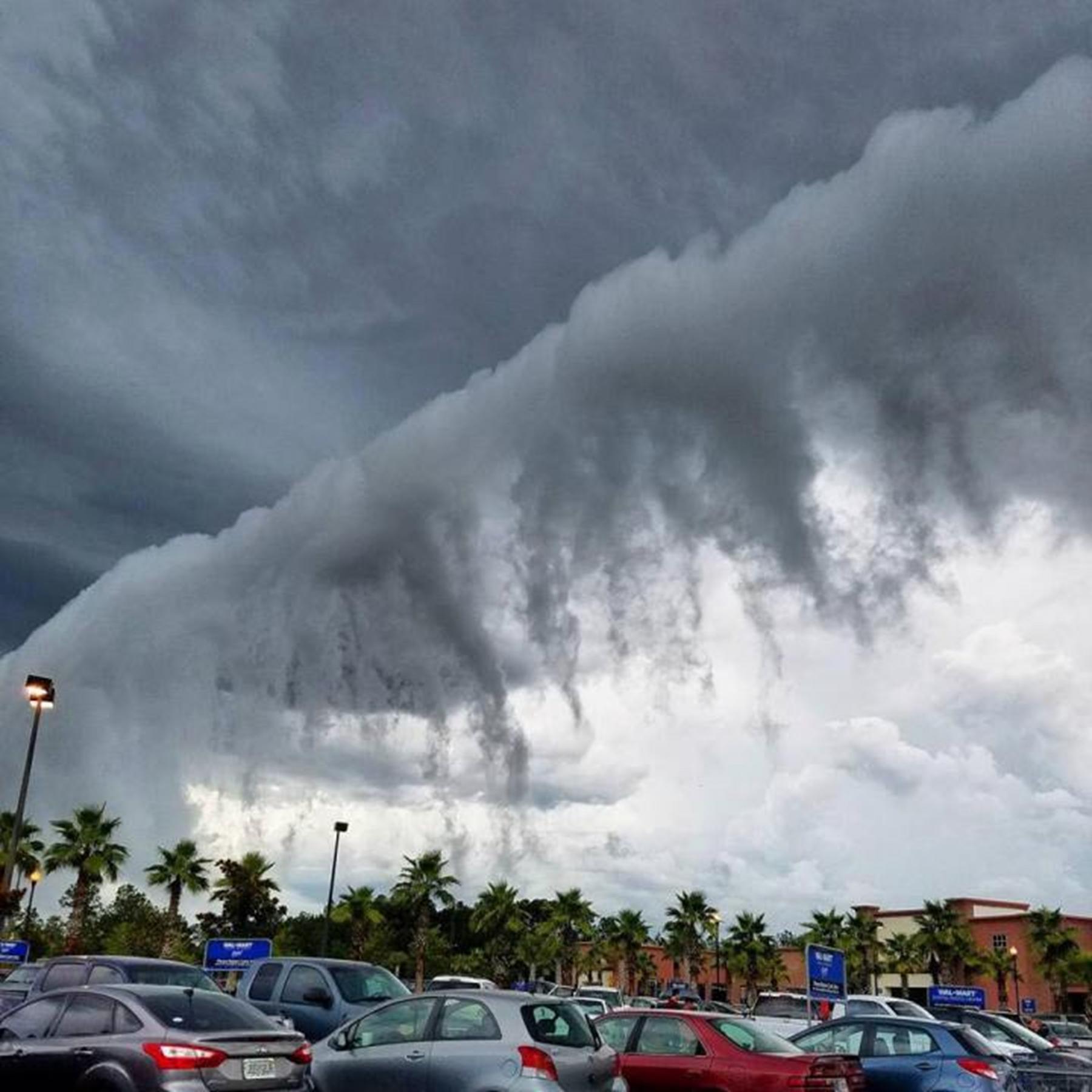
Sources: https://www.accuweather.com/en/weather-news/what-are-scud-clouds/198999
https://www.whsv.com/content/news/Scud-clouds-vs-Wall-clouds-whats-the-difference-569114741.html
https://www.whsv.com/content/news/Scud-clouds-vs-Wall-clouds-whats-the-difference-569114741.html
Chief Secretary - Edukemy Current Affairs
- Context: West Bengal Chief Secretaryin news due to political tussle between center and state government.
- The chief secretary (CS) is the executive head of the state secretariat and is the administrative head of the state administration. The CS leads, guides and controls the entire administrative apparatus of the state and holds a pivotal position to perform a variety of roles in the governance of the state.
- The appointment of Chief Secretary is an executive action of the Chief Minister and is taken in the name of the Governor of the State. They are chosen by the CM of the state who consults the central government regarding the appointment.
- Seniority, service record, and evaluation by the Chief Minister are the factors considered before their appointment. The office of Chief Secretary has been excluded from the operation of the tenure system and there is no fixed tenurefor this post.
Primary source: https://www.thehindu.com/news/national/explained-is-the-order-attaching-west-bengal-chief-secretary-unprecedented/article34678058.ece/amp/
Offshore Patrol Vessel (OPV) ‘Sajag’
- Context: Offshore Patrol Vessel (OPV) ‘Sajag’ gets commissioned into the Indian Coast Guard.
- OPVs arelong-range surface ships capable of coastal and offshore patrolling, policing maritime zones, control & surveillance, anti-smuggling & anti-piracy operations with limited wartime roles both nationally and internationally.
- It is indigenously designed and built by the Goa Shipyard Limited under the Make in India policy.
- It isfitted with advanced technology equipment, weapons and sensors capable of carrying a twin engine helicopter and four high speed boats.
 ‘Sajag’.jpg)
Primary source: https://www.indiatoday.in/india/story/nsa-ajit-doval-indian-coast-guard-offshore-ship-sajag-1808531-2021-05-30
Picture Source: https://www.republicworld.com/india-news/general-news/nsa-ajit-doval-commissions-indian-coast-guards-offshore-vessel-sajag.html
Statehood Day of Goa
- Context: statehood day celebrations.
- Post independence, the Government of India, in a bid to free Goa, requested the Portuguese to cede their territories to which the Portuguese refused.
- In 1961, the Indian Government launched Operation Vijayand annexed Daman and Diu islands and Goa with the Indian mainland.
- Goa is located on thesouthwestern coast of India within the region called the Konkan which is an escarpment rising to the Western Ghats range of mountains, which separate it from the Deccan Plateau.
- Goa has the highest GDP per capita among all Indian states.
- Most of Goa’s soil cover is made up of laterites.
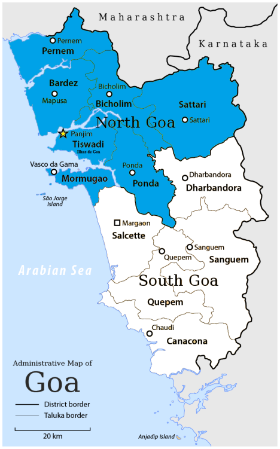
Primary source: https://www.oldgoa.in/soil-of-goa/
Picture Source: https://en.wikipedia.org/wiki/File:North_Goa_Map.png
CSC E-governance Agri Portal
- Context: Common Service Centres Special Purpose Vehicle has recently announced the launch of an e-marketplace or portal for agri services.
- The recently launched portal will enable farmers to buy seeds, fertilizers, pesticides, cattle feed, and other agri-input products, thus acting as a one-stop destination and marketplace for them. The portal is aimed at empowering small and marginal farmers, who constitute 86% of India's farming community.
- CSC SPV is a special purpose vehicle under the Ministry of Electronics & IT which provides a host of electronic services to consumers through its common service centres.
- The portal can be accessed by farmers with support from local CSCs (Common Service Centres) for buying agri-input products, renting and hire of agriculture implements and machinery, soil testing, sale of farm produce, tele-consultations, loan and insurance facility.
Primary source: https://economictimes.indiatimes.com/industry/services/retail/csc-spv-launches-agri-services-e-marketplace/articleshow/83085524.cms?from=mdr
Pakistan’s balancing act between the US and the Taliban will affect India
Essence: Editorial is presenting analysis over challenges & possibilities post US military withdrawal from Afghanistan. And how these dynamics are going to impact geopolitical strategy of Pakistan & India. Pakistan is clearly hoping to use its location — once again — to enhance US dependence on it. With Iran on the one side, and Central Asian States such as Uzbekistan and Tajikistan under heavy pressure from Russia to disallow a US military presence, options today seem to be limited, and Pakistan may well benefit once again. The Taliban hinted towards military action against such bases which may be used to launch counterterror and counter-insurgency operations. An eventual nod by Pakistan to allow US military bases, despite the Taliban threat, would raise concerns in South Asia, specifically New Delhi. The Afghan theatre, despite a US withdrawal, will push strategic and tactical rethink far beyond Washington D.C. Countries such as India, managing multiple active and challenging foreign policy fronts, will be required to divert significant strategic thought and capacity towards the Afghan theatre in the coming months.
Why you should read this ?
- To know about the recent developments on future of Afghanistan.
- To learn more about the ramifications of the latest Taliban Pakistan summit in Islamabad.
- To have a better understanding on geopolitical challenges & opportunities that will arise following the US military withdrawal from Afghanistan.
Needed, a resilient health care system
Essence: The second surge of Covid-19 in India has indeed been ferocious, brought untold misery to numerous, overwhelmed the healthcare system and affected every aspect of our daily lives. In this context, the article emphasises on investing now in ensuring a resilient health system that will serve us well in normal times and during times of disaster.
Why you should read this article?
- Briefly know the meaning of a resilient health system.
- Identify the key guiding principle of investment, important stakeholders and focus areas of investments.
- Identify the steps that need to be taken to build a resilient health care system such as A well-regulated private sector, stewardship role of government, role of communities in planning and monitoring, social audit.
Article Link: https://www.thehindubusinessline.com/opinion/needed-a-resilient-health-care-system/article34691976.ece
Food safety during Pandemic
Essence- To enhance the benefit of package in response to COVID-19, the government has announced several schemes to maintain supply of food grains to states and union territories for distribution under the National Food Security Act (NFSA) and Targeted Public Distribution System (TPDS). In spite of instrumental role of TPDS, more than 10 crore people have not been covered by the food safety net. So, the States/ UTs need to develop an inclusive NFSA/TPDS in association with the Central Government. To improve the NFSA coverage ratio and infuse inclusivity in TPDS, we can integrated management of PDS through automation of operational fair price shops (FPS) or Aadhaar-seeding of ration cards helps deepen the portability of One Nation One Ration Card (ONORC) to reduce targeting (inclusion/exclusion) errors and improve other benefits. To mitigate deprivation of the poor and migrant labourers- the Food and Civil Supplies Department should keep a vigil on the functioning of FPSs; second, data governance should be put in place to increase transparency and accountability of TPDS; third, States and UTs should allocate food grains to those who are excluded from the TPDS by means of food coupons, etc.; fourth, the community kitchen concept, etc.
Why you should read this article?
- To get an overview of efficacy of NFSA and TPDS during this time of pandemic.
- To understand the issues related and what could be the possible solution to cover more people under food safety net.
Article Link : https://www.thehindubusinessline.com/opinion/food-safety-during-pandemic/article34683498.ece
Diverse Tribal Tradition of India: Sansi Tribe of Punjab
...the so-called ‘criminal’ tribe.
About the tribe:
- Originally of Rajput descent, the Sansi tribe have been a nomadic tribe and have finally settled in different parts of Punjab.
- For time immemorial they have wandered Punjab around Ludhiana, Amritsar and Karnal.
Nomadic existence is a result of compulsion, not choice:
- The tribe was made to live on the fringe of society and has been neglected, pushed away from civilization for decades.
- Tribe has been pushed to its limits, with no land to call their own
- Deprivation has shaped their lifestyle, with prostitution, beggary, theft and criminal activities pilfering their habits out of desperation.
- To make matters worse, they have been labelled as Vagrants and Criminals.
- Sansis women are especially downtrodden, both economically and socially.
Thinks to ponder:
- What are criminal tribes, Notified-Denotified tribe, etc.
Where can we use this case study:
- Atrocities inflicted by the British and masses on tribe, problems faced by the tribal population.
Share the article
Get Latest Updates on Offers, Event dates, and free Mentorship sessions.

Get in touch with our Expert Academic Counsellors 👋
FAQs
UPSC Daily Current Affairs focuses on learning current events on a daily basis. An aspirant needs to study regular and updated information about current events, news, and relevant topics that are important for UPSC aspirants. It covers national and international affairs, government policies, socio-economic issues, science and technology advancements, and more.
UPSC Daily Current Affairs provides aspirants with a concise and comprehensive overview of the latest happenings and developments across various fields. It helps aspirants stay updated with current affairs and provides them with valuable insights and analysis, which are essential for answering questions in the UPSC examinations. It enhances their knowledge, analytical skills, and ability to connect current affairs with the UPSC syllabus.
UPSC Daily Current Affairs covers a wide range of topics, including politics, economics, science and technology, environment, social issues, governance, international relations, and more. It offers news summaries, in-depth analyses, editorials, opinion pieces, and relevant study materials. It also provides practice questions and quizzes to help aspirants test their understanding of current affairs.
Edukemy's UPSC Daily Current Affairs can be accessed through:
- UPSC Daily Current Affairs can be accessed through Current Affairs tab at the top of the Main Page of Edukemy.
- Edukemy Mobile app: The Daily Current Affairs can also be access through Edukemy Mobile App.
- Social media: Follow Edukemy’s official social media accounts or pages that provide UPSC Daily Current Affairs updates, including Facebook, Twitter, or Telegram channels.

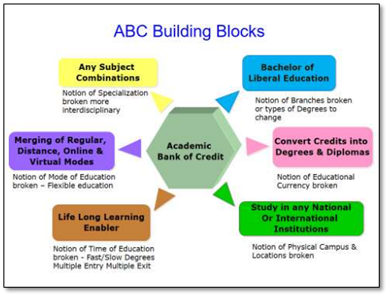
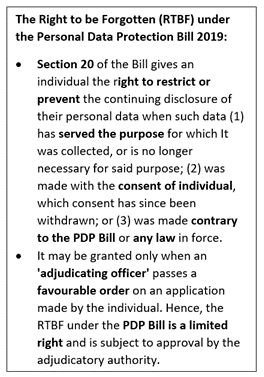
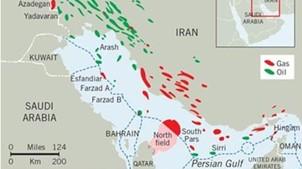
.gif)
